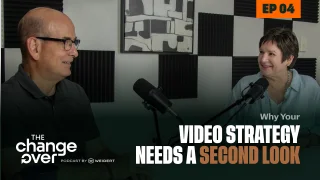Lead Nurturing 101: Definitions & Best Practices for Inbound Marketers
Written by
When someone’s out fishing and they get a bite, they understand it is only the first step in landing a fish. You need to reel it in with deliberate action and finessse. Reel the line in too aggressively, and the line will break; reel it in too slowly and the fish will jiggle loose and get away for someone else to catch!
It’s all about nurturing the connection. When a lead shows interest in your product or service, whether by filling out a form on a content landing page or clicking a link in an email, that’s your cue to continue priming the pump and earning their trust.
How can you accomplish this? We have a little Lead Nurturing 101 here to get you thinking about how you can turn potential customers into your best cheerleaders.
Lead Nurturing Defined
Essentially, lead nurturing is remaining in contact with potential customers who have taken an action that demonstrates their interest in what you’re selling. That can be done in a number of ways, depending on where they are in their buyer’s journey.
The role of lead nurturing in inbound marketing is simple: to turn leads into loyal customers.
It’s about building relationships and gaining trust and credibility with those customers so they’ll not only make a purchase of your product or service once, but will come to you again and again for what you’re offering.
The cherry on top is the possibility of these new customers becoming loyal brand ambassadors, spreading the good word about your business!
So, how can this be done?
Nurturing Leads in Marketing and Sales
First and foremost, you must have your goals clearly defined. While your Marketing and Sales teams may be trying tactics unique to their areas of expertise, they should both have the same endgame in mind — helping achieve your business growth goals.
Your leads won’t all be in the same stage of the funnel. They could run the gamut between those who are just becoming aware of what you can do for them and those who’ve already filled out a lead form and are considering you for the purchase. How you nurture these leads will depend on where they are in the funnel and how you’ve segmented them.
This is where the marketing and sales teams really need to shine. What can each one do to successfully nurture leads?
Marketing Objectives
Marketing is where the relationship begins as you create content that addresses the needs of prospective customers, increasing your credibility with them. The beginning of this relationship may come from a visit to a blog article or landing page through organic or paid search, but it can also come from offline sources such as trade shows and networking.
The goals for each of your nurturing campaigns depends on the segmentation of your contacts. For example, if you only have someone’s email address and nothing else, nurturing them will be a different process than what you’d do to nurture someone whose name, location, and interests you know.
For the person who’s just an email address in your CRM system for the time being, you might consider nurturing them by sending emails with links to earn a second conversion in order to gain more information and qualify them as a Marketing Qualified Lead (MQL).
If you are nurturing someone who's already qualified as an MQL, then the campaign goal will be to steer them into a Sales Qualified Lead (SQL) stage — someone whose behaviors demonstrate they are ready to talk to your sales team — by drawing them back to your site and/or your sales team for further engagement and conversions.
Sales Objectives
Nurturing doesn’t stop when the SQL is handed off to sales. The goal in the sales stage is to further build the relationship on a more personal level to convert this SQL into a customer.
This doesn’t mean calling every SQL and talking about last week’s big game before going into a sales pitch (though that’s still a possibility!); relationship building can include such under-your-nose opportunities as connecting and interacting with the lead’s social media posts, sending a video or other helpful content related to pages they’ve viewed on your site, and other ways of connecting without pestering or being too invasive.
Personalization is key here. At this stage, you already know more about what interests this customer and what they’re looking for. Make them really feel like any message you send was catered directly to them.
Tools for Scaling Lead Nurturing
Hopefully, you’ll have plenty of leads to nurture, in which case you’ll need tools to help you scale and optimize your nurturing efforts.
For the Marketing team this means marketing automation and smart workflows for campaign execution.
Methods like mapping out email touchpoints for your leads in order to give them the most helpful information at the perfect time, and using tracking data to better understand someone’s online behavior, can go a long way. Remember the inbound flywheel framework and keep in mind how you can nurture leads in all stages as you develop your nurturing and automation strategies.
Learn More: 8 Ways to Utilize HubSpot Workflows
For the Sales team this means implementing sales enablement tools like HubSpot Sales Hub to help your team efficiently and successfully start conversations with more SQLs and turn them into closed-won opportunities. HubSpot Sequences in particular is a tool that lets you create targeted templates for emails, schedule emails to be sent at appropriate times, and even automatically unenroll those contacts if they go through with scheduling a meeting or email you back.
Such tools and strategies can help you convert this lead into a customer and, from there, hopefully an ambassador of your brand. But the process doesn’t end there!
Learn More: How to Maximize Your Inbound Marketing Funnel for Sales
Nurture Your Existing Customers
Too many marketers and sales people drop the ball once a prospect becomes a customer, missing the enormous value current customers can have in helping achieve your business growth goals.
Nurturing existing customers has two potentially huge benefits:
- Delighting customers with content that provides additional value drives continued engagement. The key is not treating them like a new prospect you don’t know, but by continuing to cater to their specific interests and needs. Personalization and segmentation matters! The goal here is to turn those delighted customers into loyal promoters of your brand, thus powering your flywheel with even more new leads.
- Expanding relationships and awareness of ALL the products and services your company offers can generate upsell and cross-sell opportunities. You don’t want a customer to just buy from you once, right? Repeat customers keep businesses alive, and there are a multitude of ways to nurture existing customers to keep them coming back. Whether it’s highlighting related services — like a powdered coating division in a campaign to metal fabrication customers — or sending case studies of how you helped one customer solve a complex design problem to those who aren’t utilizing your Design for Manufacturing services, the possibilities are nearly endless!
Improving Your B2B Nurturing Campaigns
I bet you check your email dozens of times daily, and so do your customers. Email is a marketing opportunity you don’t want to waste, and one of the primary channels for lead nurturing. With our guide, 10 Ways to Improve Your Email Metrics, you can learn why segmentation matters, how personalization is important, and more. Click the link below to get your free copy today!
Subscribe To Our Blog
Information. Insights. Ideas. Get notified every time a new Weidert Group blog article is published – subscribe now!
You May Also Like...

Search Engine Optimization
Optimize Your Industrial Website for AI Search

Marketing Technology
Why Unified Data Efforts Fail (and How Manufacturers Can Fix It)

Search Engine Optimization
How Falcon Rebuilt Industrial AI Search Visibility in 2025
Accelerate Your Growth with
Weidert Group
If you’re ready to explore a partnership, request a personalized consultation with our team.






